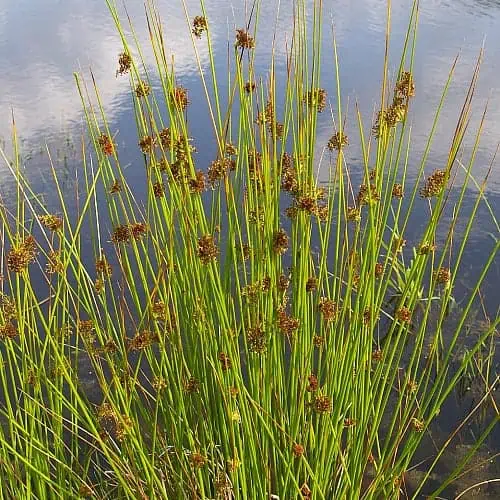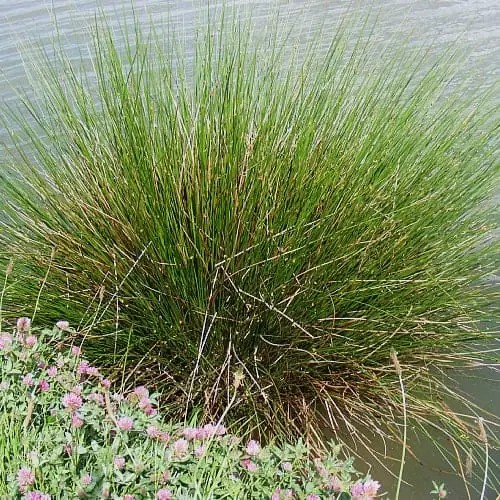
Soft rush is a true rush in the Juncaceae family. This grass-like plant is also known by the common name of “common rush.” In North America, Juncus effusus shares the common name “soft rush” with Juncus interior. Like most species in the Juncus genus, soft rush is found in moist soils such as those present in wetlands, marshes, and pond margins. Soft rush grows in clumps along the edges of water sources, resembling grasses or sedges.
If you’ve taken a botany class, you may remember the saying “rushes are round and sedges have edges”—this proves true for soft rush, which has hollow, cylindrical stems. Yellow flowers appear at the top of each stem—these flowers are not especially showy, but will add some color to your pond or garden.
There are five subspecies of soft rush: J. austrocalifornicus, J. effusus, J. laxus, J. pacificus, and J. solutus. Soft rush is widespread globally and can be found on every continent but Antarctica. This plant is easy to grow, making it a popular choice as a pond plant.
Facts, Benefits & Uses of Soft Rush

Soft rush can be an important part of preventing soil erosion when planted on the edges of a water source. In addition, soft rush is an important plant for wildlife, providing habitats for birds and small mammals. Muskrats feed on the roots of this plant, and birds may eat its seeds. Soft rush is a larval host plant for a variety of invertebrate, including the red sword-grass moth (Xylena vetusta).
In addition to their benefits for wildlife, soft rush plants also act as excellent filters— Juncus effusus roots have been shown to hold onto large numbers of beneficial bacteria, which helps in the promotion of clean water. Interestingly, soft rush fibers have been used to produce filters for both cigarette smoke and textile dyes in water. Although these are quite modern developments, soft rush has been useful to humans throughout history; Native Americans used it for basket weaving, various cultures used to make rushlights (an alternative to candles), and the Japanese use it to make tatami mats.
Soft Rush Growth, Hardiness & Climate

Soft rush grows at a medium rate and does best when planted in moist soils, such as those near a pond margin. When it reaches its full size, it will be around three to four feet tall, with a two to three foot spread. These plants have rhizomes, which help them to spread—you can divide the roots of soft rush as needed in order to help mitigate its coverage.
Like the majority of rush species, soft rush is a wetland plant that tends to be found in moist soils, such as those found along the edges of rivers, ponds, creeks, or in wetlands. Soft rush does best in hardiness zones 2-9, with ample sunlight and moisture. This plant does produce flowers, but they are not especially showy—soft rush is prized more for its unique stems.
How to Plant Soft Rush In Ponds

Immature soft rush plugs should be planted in two inches of moist soil, while mature plants can be planted six inches deep in moist soil, and can have the first few inches of their stems covered by water. Soft rush can grow in both standing water and damp soil, so an ideal location for this plant is at the edge of your pond. If planting in standing water, it is a good idea to place some small rocks or gravel around the base to help hold it in place while it becomes more established.
How to Care For Soft Rush
Soft rush tends to be an easy plant to care for, provided is has enough water and sunlight. Planting it marginally along the edge or just in the shallows of your pond will help to ensure it has an ideal environment.
As soft rush spreads through rhizomes, you can divide its roots to control spreading. Be sure to properly dispose of whatever you are not replanting, and clean any trimmed or dropped foliage from your pond to encourage healthy water quality. If you live outside of its native range, do not “dispose” of this plant by just tossing it aside into a natural area, as it can then colonize and wreak havoc on ecosystems. Instead, dispose of it in the compost or trash.
How to Winter Soft Rush

Soft rush is able to survive winters within its native hardiness zones (2-9), but may not survive in colder zones. This plant will turn brown in the winter, so do not be alarmed if you notice this! If you live below hardiness zone 2 (you poor soul), you may choose to plant it each year, treating it as an annual rather than a perennial.
Is Soft Rush Toxic, Poisonous or Invasive?
Soft rush is widespread globally, so introducing it to new areas is not of extreme concern. However, soft rush can be invasive in certain situations, so take care when deciding whether to plant it in your area. Do not plant soft rush in natural areas, but instead keep it in your own personal pond or water garden.
Soft rush is not known to be toxic to humans, pets, or livestock, and is in fact eaten by a variety of wildlife.
Is Soft Rush Edible? Will Fish Eat it?
Soft rush, especially its roots and soft shoots, is edible to humans. A variety of wildlife use soft rush as a food source, including small mammals, birds, and invertebrates. Pond fish are unlikely to eat the roots, but they may prey upon small invertebrates that call soft rush and its roots home. If pond fish do happen to nibble on the roots, they should not experience any negative health impacts.
Where to Buy Soft Rush Plants & Seeds? (UK & US)
Soft rush is easily obtained in most places, as this species is quite widespread. You’ll likely be able to find it in person at a plant nursery, or online.

